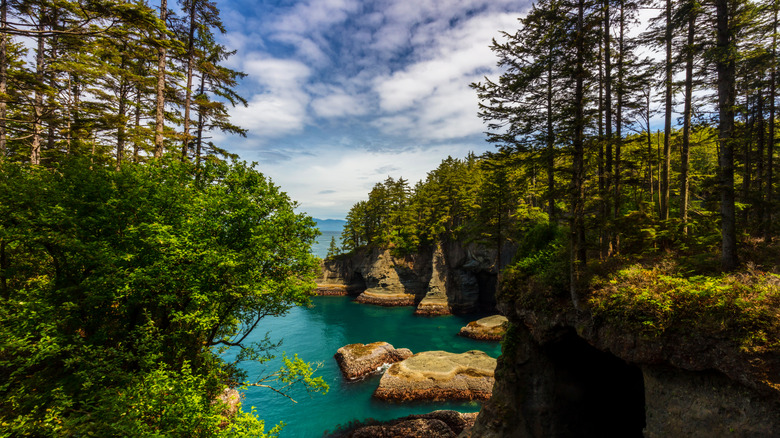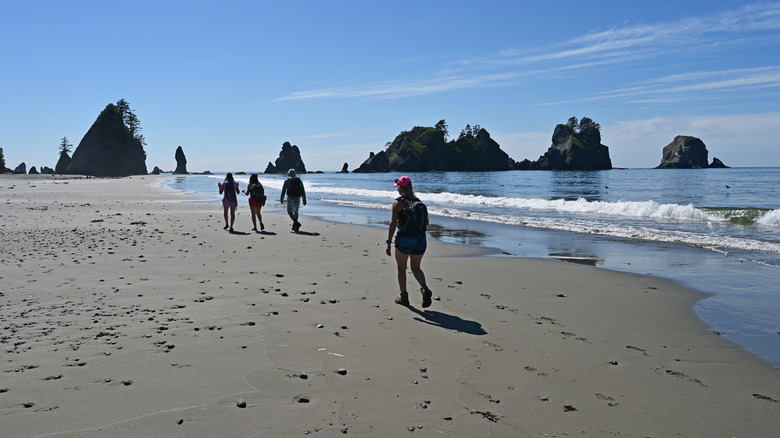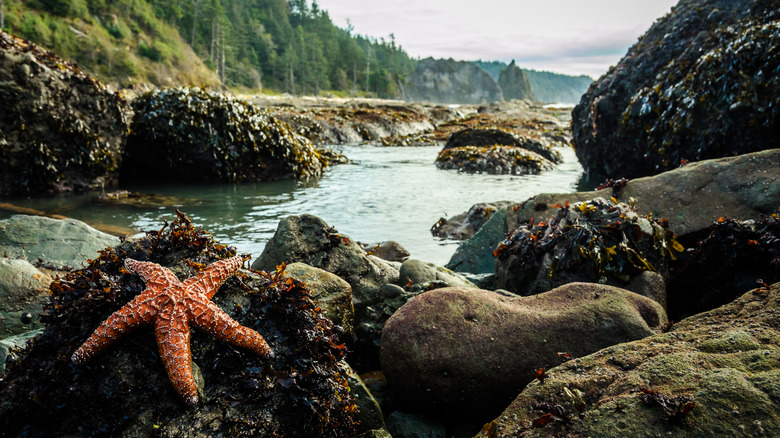America's First Tribal Scenic Byway Is A Short And Sweet Washington Road With Ocean Views
Situated in the extreme northwest corner of the contiguous U.S., Washington state's Olympic Peninsula is home to some of the most arresting natural scenery in the nation. Though just a four-hour drive from Seattle, "it feels much farther, as if you have passed into an otherworldly realm," as bestselling writer Megan O'Rourke wrote in the New York Times. Surrounded by the Pacific Ocean, the Strait of Juan de Fuca, and Hood Canal — one of the country's few fjords outside of Alaska — the peninsula boasts jagged peaks, deep valleys, glaciers, lakes, rainforests, and many miles of unspoiled, undeveloped coastline. It's a nature lover's dream, and one of its iconic spots, Cape Flattery, is accessible by car.
At just 12 miles, the Cape Flattery Tribal Scenic Byway may be short, but it packs a punch when it comes to scenery and culture. Beginning at the end of State Route 112 in the town of Neah Bay, the byway winds through the Makah Reservation, offering jaw-dropping vistas of both the Strait of Juan de Fuca and the Pacific, before ending at Cape Flattery, the northernmost point in the Lower 48.
To drive along this byway is to experience North American nature in its most thrilling, raw form, including sheer cliffs, sea stacks, sandy beaches, and wildlife such as bald eagles and migrating whales. It's also a chance to learn about the Makah Tribe, the people who have called this wet, rough, but gorgeous part of the country home for millenia.
Driving and hiking
Home to the Makah, the small settlement of Neah Bay also draws anglers from all around due to its world-class salmon and halibut fisheries. The Cape Flattery Tribal Scenic Byway begins here, but before you set off down the road, soak up some local culture at the Makah Cultural & Research Center Museum. This is a treasure trove of precious items and historical artifacts, including baskets, masks, cedar clothing, and a reconstructed longhouse.
The byway hugs the spectacular edge of the Straits of Juan de Fuca before crossing over to the Pacific side. Here, you can access the Shi Shi Beach Trail (pronounced "shy-shy"), a moderate, 8.8-mile out-and-back path that takes you down to the shore, but make sure to wear sturdy footwear and appropriate clothing, as things can get very muddy. This wide stretch of sand is home to seals, otter, deer, and birds of prey and is most famous for a string of dramatic sea stacks at the south end of the beach called Point of Arches. It's possible to camp here, but access to the beach requires a Makah Recreation Pass, which can be purchased in Neah Bay. Campers must also obtain an Olympic National Park wilderness permit, available at the park's visitor's center in Port Angeles.
The road ends at the rugged, windswept cape that bears its name. The Cape Flattery Trail is a very easy, 1.2-mile roundtrip path that takes you to the very edge of the continent. It terminates at two viewing platforms that allow you to marvel at the majestic ocean rocks and sea caves, as well as the lonely form of Tatoosh Island and its lighthouse, surrounded by the roiling waters of the Pacific. Be on the lookout for bald eagles and sea lions, and if you're lucky, you just may catch sight of a pod of whales swimming offshore.
While you're in the neighborhood
As impressive as it is, the Cape Flattery Tribal Scenic Byway offers just a taste of the deep splendor the Olympic Peninsula has in store. Make sure to check out other local attractions, such as Seiku and Clallam Bay, where you can try your hand at fishing, enjoy kayaking, surfing, scuba diving, birding, beachcombing, or finding tidal pools.
You can also head down to the cool beachside town of Port Angeles for some further exploration. There, you'll bask in front of a craggy backdrop of the snow-capped Olympic mountains while feasting on local Dungeness crab, fresh clams, and salmon. Once you've had your fill, hop back into the car and make your way up to the Sol Duc Hot Springs, where you can rent a rustic cabin in the forest and soak in the spring's restorative natural waters.
Just a short drive from Neah Bay is Lake Ozette, a beautiful body of water known not just for its crystalline waters but also for the great cultural significance it holds for the Makah people. Archeologists have discovered evidence of a culture dating back over 2,000 on its shores, along with over 50,000 artifacts that are now housed in the Makah Museum. Just make sure you pack for rain, as the Neah Bay area averages over 201 days of measurable precipitation a year.


